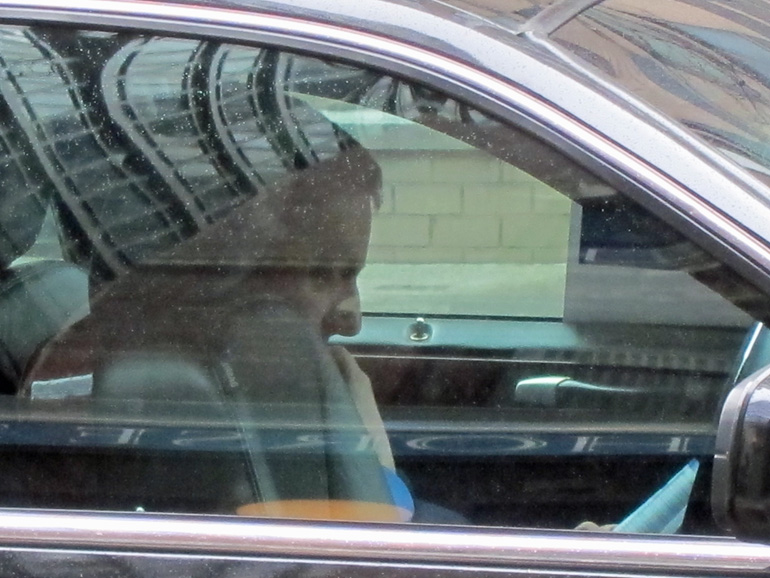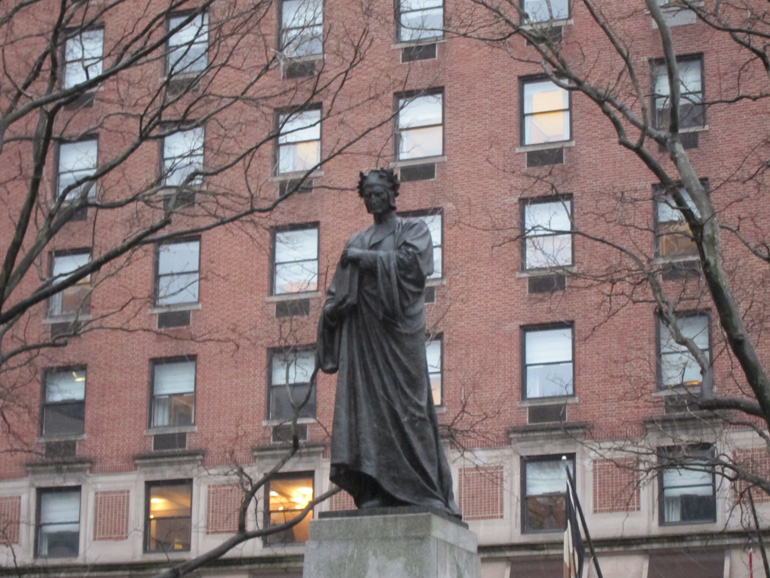
What a strange movie Stoker is! Arresting in its course, it leaves no very strong impression afterward. There is a psychopathic uncle, but his sister-in-law and niece are pretty strange birds, too, and the movie unfolds without a baseline of sanity. If someone more or less normal were to be dropped into the film’s curiously affectless atmosphere for long enough to get to be known, one might shudder. But for all that four people are gruesomely murdered (all more or less offstage, or out of view), Stoker is not frightening. It’s not even creepy. It’s foreign, is what it is. The first English-language project by Chan-wook Park, the director of eight Korean features, Stoker is easy to dismiss as “stylized.” It’s a stunning picture, certainly. The interiors, especially, are powerful. It’s as though their bare, underdecorated look represented the absence of psychological health.
At least three times, I was convinced that Stoker is aimed at teens. India Stoker (Mia Wasikowska) is a somewhat fey adolescent, a straight-A student who dislikes being touched, and whose best childhood moments seem to have been spent out shooting birds with her late father, Richard (Dermot Mulroney). India does not get on well either with her mother (Nicole Kidman) or with the boys in high school. Her distrust of the uncle who shows up for the first time at her father’s funeral is the most ordinary thing about her, and the second-most ordinary thing is the attitude that follows distrust. But if Stoker were aimed at young people, India would turn out to be a regular kid underneath all the weirdness, and this she most definitely is not.
What do I know; it’s a long time since I was young people. Ms Kidman gives us a mom that would make the most well-adjusted teenager squirm. Evelyn is, I suppose, a standard-issue narcissist. She takes no interest in that part of the world that is not centered on herself. It is impossible to imagine her doing anything motherly for her daughter, and indeed she acknowledges that she has never brushed India’s hair. This comes up in a scene that captures the strangeness of Chan-wook Park’s work. There is a knock at Evelyn’s door, and she arises expectantly from her chaise longue. Her visitor turns out to be unexpected: India. Evelyn just manages to keep down the urge to ask India to leave, so as to clear the field for a more interesting arrival, and India knows that she is being annoying (but she is always annoying). Pretty soon, India is brushing her mother’s hair, and what has been a study in the pointlessness of adolescent existence (seen from the standpoint of both parent and child) artfully dissolves into the object of Evelyn‘s resentment. As Evelyn complains about all the time that India spent with her father, her brushed hair imperceptibly morphs into the reeds of a duck blind, in which we see Richard and India aiming their rifles.
Mia Wasikowska is perfect as India; Nicole Kidman is simply perfect. Yet another strange turn in this compelling actress’s catalogue of oddities! I haven’t seen them all, by any means, but the one that Stoker brought to mind was Suzanne Stone Maretto, the deluded “heroine” (also a narcissist) of To Die For. Evelyn is Suzanne with a wider range of pouts, and much less need to be on her best behavior. When India ventures that her mother never brushed her hair because she was “busy,” Evelyn demurs. “Doing what?” — and there’s a whole horror film right there. Ms Kidman looks terrific, without any telltale of “work” except that of unlikely youthfulness. But her glamour is all that she has been given to work with, so that the performance is charged with a frustration that I read as “Can’t I be bad?” This is not at odds with the film’s mood, but unlike her costars, the actress does not disappear into the movie.
Matthew Goode, playing Uncle Charlie (who is bad), has one great scene, and he plays it so brilliantly that you wish there were more of it, a lot more. This is a scene in with his brother, who has good reason not to want Charlie anywhere near his family. “What kind of family is it if you can’t take me home,” Charlie asks with a voice and a face that slips vertiginously between charm and tears. Otherwise, Mr Goode is asked to be a sort of Cary-Grant hunk, gazing steadily and calmly at everyone and radiating a trustworthiness so powerful that it can’t be real, except perhaps in an insurance ad. What you can count on this guy to do is strangulation and dismemberment.
But, seriously, how long would you wait to call for help after discovering the housekeeper’s head in the deep-freeze? To which you had been sent by your strange uncle? When the sheriff does show up (in connection with another but hardly unrelated missing-person case), India steers him away. Later — well, later, let’s just say that she turns out to be a lot more like her Uncle Charlie than another cinematic niece.
Amazingly, Evelyn Stoker is still alive at the end of the movie. I hope that it doesn’t spoil the movie to hear this. She wriggles so much like bait throughout Stoker that a big bite would be anticlimactic. No, she lives. To do what?
***
Could I have found anything less like Starting Out in the Evening to follow it with than Christopher Wilson’s Dancing With the Devil (St Martin’s Griffin, 2000)? Oh, I suppose so, but it’s hard to imagine.
In his introduction, Wilson writes that, after learning about Jimmy Donahue from Caroline Blackwood’s nonpareil report, The Last of the Duchess, “I had to know more.” I’m glad that he got there first, because, when I had to know more, there was his book to read. I don’t know how he stomached the research, though. Quite aside from the difficulty of rounding up witnesses who were already elderly when Blackwood was writing and reading a lot of tittle-tattle books, the project necessarily entailed immersion in the ponderous and suffocating dreariness that went with “the Woolworth millions.” F W Woolworth had three daughters, and one of them, Helena, does not much figure in Wilson’s book. Another, Edna, appears only to have died and to have been discovered by her four year-old daughter, Barbara, who of course would grow up to be one of the century’s two “poor little rich girls. (The other was Doris Duke.) The third, Jessie, is the monster in Wilson’s book. Jimmy Donahue may have been “mad, bad, and dangerous to know,” but he was not only made but maintained that way by his ghastly mother, who used her fortune to control him, both by spoiling and him blocking his few efforts to make something of himself. She outlived him, and was outlived only briefly by her older son, Woolworth — a much more decent chap, but still a miserable alcoholic. She opened her purse all the way when Jimmy got mixed up with the Windsors, and they took generously for over four years, until, finally, as it seems, everyone got on everyone else’s nerves.
Reading about these people might ultra-depressing, if Wilson didn’t cut through their stories with the grace of Fred Astaire. They seemed to have possessed an updated version of the Midas Touch: everything they possessed ceased to mean anything to them. Barbara Hutton’s cycle of marriages was as dismal as the routines in a novel by Ivy Compton-Burnett. One of the nice things about Dancing With the Devil is learning that she actually had at least one good friend — her cousin, Jimmy Donahue.
I had always considered myself a fairly adequate Windsor-watcher, familiar with the key details. But I had never heard of Jimmy Donahue until The Last of the Duchess. That’s not true, as it turns out; Donahue is mentioned, very much as passingly as possible, in Anne Sebba’s solid biography of the duchess, That Woman. Never having heard the outlandish Donahue stories, however, I didn’t pay any heed. The idea that the Duchess of Windsor had an affair with a homosexual and considered divorcing the Duke and marrying him hit me like a bad joke in Blackwood’s book, on a par with the wonderfully florid speculations that make The Last of the Duchess more of a personal memoir than an account of the sick old woman. So much for “the romance of the century!” And I’d always thought that Barbara Hutton had all the Woolworth millions. (Well, I never could pay any attention to her.) Now, though, I had to know more.
Now that I do know more, I can testify that Christopher Wilson’s book is really pretty remarkable. It’s brisk, and rarely censorious. (The facts speak for themselves.) Wilson understands that fortunes and titles can make the people attached to them so generally interesting that their public lives become unscripted but riveting performances, regardless of dramatic significance. These are not people that you would want to know — that’s not the point. The point is that you hope that you would not like them if, by some miracle, you woke up rich or titled one day, and found all the world bent to your wishes. Because these people developed wishes that the world would not grant. Wilson never talks nonsense about “testing the limits,” but the figures in his book often behaved as if there weren’t any. And there usually weren’t. Let’s just pick a random chocolate out of the box:
Jimmy became intimately acquainted with Francis Spellman, the Cardinal Archbishop of New York, a notorious homosexual predator and friend of Jessie. St Patrick’s Cathedral was a great cruising ground, particularly late Mass on a Sunday, and the cardinal was rumoured to have deflowered many young men. Jimmy once welcomed him to his mother’s apartment at 834 Fifth Avenue wearing a ball-gown and high heels.
And that’s not even one of the outlandish stories. (I attended a pre-deb dance in my teens at which Cardinal Spellman turned up in “my best gold cross.”) I am not going to repeat the outlandish stories. Kathleen finds them disgusting, so I feel somewhat sheepish about exploding with laughter when I read them, especially the one told by Aileen Plunkett in which, among other things, Jimmy instructs a waiter that he likes his meat “sliced very fine.” I am not going to ask what it was that made Jimmy Donahue so persistently forgivable — but he was forgivable; that’s how he stayed out of jail. I am certainly not going to chatter about Wallis Windsor’s sexual proclivities (although I’m inclined to agree, with Freda Dudley Ward, that the duke was a masochist.) To make inquiries about these people is to pop the balloon of the show that they’re putting on, and, without that, they’re nothing. The show is astonishing for the simple reason that the members of its cast roamed the earth at liberty. And within my lifetime — we’re not talking about Dark Age depravity! I certainly never thought that I would see Cardinal Spellman called “a notorious homosexual predator” in a book published by a reputable house. But there you are — it seems that he was, the head of my archdiocese.
In addition to connecting a number of dots for me, Wilson’s book makes it very, very clear that there was no collapse in social values in the 1960s. There were no values to collapse. When people at the very top of the tree carried on as the Windsors and the Donahues did, with impunity, there was nothing for the rest of us to do but to fall in line.




















